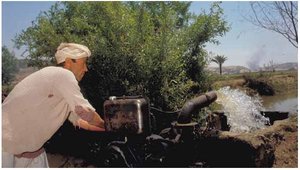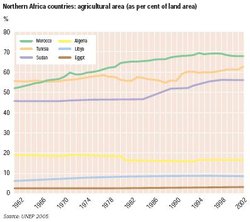Northern Africa and land resources
Contents
Introduction Northern Africa: arable land (Source: UNEP (Northern Africa and land resources) 2005)
Northern Africa is characterized by mostly arid areas, yet land resources play a pivotal role in its development and the well-being (Human well-being and livelihoods in Africa) of its people.
The main three land-use categories are cultivated land, forests and rangelands. Agricultural land (Agriculture and development in Africa) constitutes 233,590 hectares (ha), which is nearly 28.8 percent of the total land area.
Arable land in Northern Africa is of varied soil characteristics, which belong to the Aridisol group. Aside from the alluvial soils of the river basins, the desert soils are of inferior chemical, physical and nutritional properties. In general, soil resilience is rather weak with rapid responses to development and degradation (Land degradation and desertification in Africa). The extent of use of arable land varies considerably among the countries. Some countries have already fully utilized the land resources available to them, while others are still to fully utilize them. In Sudan, for example, there are vast areas of potential arable land yet to be developed. The extent to which irrigation is used varies dramatically, with 99.94 percent of all agricultural land in Egypt being under irrigation, compared with less than 1.5 percent in Algeria and Sudan.
Over the past 50 years, the traditional systems of cultivation and conservation have broken down. Productivity has declined as soil erosion from overcultivation and overgrazed lands has reduced soil fertility. Coupled with naturally inadequate drainage, this has led to the accumulation of high levels of soluble salts, especially in Egypt and Sudan. In Egypt 3.4 million ha of all agricultural land is irrigated. About one million hectares are suffering from primary or secondary salinization. This is in part due to the use of saline drainage water and brackish water in irrigation.
More than 57 percent of the total land of Northern Africa is threatened by desertification (Land degradation and desertification in Africa).
Endowment and opportunities
 A farmer using an irrigation pump near the village of Talla in the El Minya district. Egypt-Minya Agricultural Development Project.
A farmer using an irrigation pump near the village of Talla in the El Minya district. Egypt-Minya Agricultural Development Project.(Source: G. Bizzari/IFAD)
The continued expansion of the oil sector contributed to an overall growth rate of 4.8 percent in 2004, close to that in 2003. Gross domestic product (GDP) was projected to be 5.2 percent for 2005, led by growth in the agricultural sector (Agriculture and development in Africa), assuming good weather conditions and continued gains from oil through foreign investment inflows to oil-related activities in Libya, Mauritania and Sudan.
Growth in tourism in Morocco and Tunisia offers opportunities for development. In Egypt, tourism continues to be an important industry and a key factor in its sustained growth of 3.2 percent in 2004. Land cultivation is becoming increasingly dualistic in nature. A high technology agribusiness sector is developing alongside traditional smallholder agriculture. The cultivable land covers between 22 and 25 percent of the total land area. The percentage of agricultural land (including arable, forests and rangeland) to the total land area ranges from 2.6 percent in Egypt to 77.4 percent in Morocco. The percentage of irrigated land as a percentage of arable land varies between nearly 100 percent in Egypt, where rain-fed agriculture is almost negligible, to around 15 percent in Morocco and Sudan, where arable rain-fed areas amount to 16.1 percent and 3.32 percent respectively. The expansion and intensification of land use in marginal dry areas has greatly exacerbated the risk of land degradation (Land degradation and desertification in Africa).
Challenges faced in realizing opportunities for development
Land resources are affected by population dynamics. Since 1970, the population size has doubled and is continuing to grow at an average of 2 percent per year. Population growth, coupled with the resulting higher consumption of food commodities, places new pressures on resources.
Despite the increase in agricultural land resources, the rapid population increase has caused a decline of the per capita share of cultivated land. High population in coastal towns, such as Alexandria in Egypt, is resulting in pollution-related degradation (Land degradation and desertification in Africa) and thus threatens the tourism industry as well as local livelihoods (Human well-being and livelihoods in Africa).
 Northern Africa countries: agricultural area (as % of land area)
Northern Africa countries: agricultural area (as % of land area)(Source: UNEP 2005)
Degradation processes of the available land resources are varied and widespread. The main pressures include rapid population growth, climatic stresses, drought and overgrazing. The resulting impacts include serious losses of soil through wind and water erosion, loss of soil fertility, loss of biodiversity through degradation of natural plant cover and deforestation, pollution of land and water resources, increased soil salinity and waterlogging, and social impacts including increased poverty and rural-urban migration.
Combating such degradation (Land degradation and desertification in Africa) processes is of paramount importance for the sustainable development of the land resources, improving agricultural productivity (Agriculture and development in Africa) and food security, securing a safe environment and enhancing socioeconomic benefits. In response to the various adverse impacts of degradation processes, the countries of Northern Africa are carrying out various activities to assess and monitor the degradation processes.
Lack of secure land tenure has been reported as a major constraint to land development. Lack of secure property rights is a hindrance to land development and improvement, and does not support the development of trade. It may be a factor in environmental degradation.
Earthquakes are one of the natural disasters faced by Northern African countries. Establishing a regional network of seismic stations is necessary if the Earthquake Prognostics Strategy is to be implemented. Other tasks of high priority are:
- Studying the relation between the modern tectonic movements and the seismic activity to make microzonation maps which may be applied to better designed buildings, dams and power plants;
- Increasing public awareness and preparedness for earthquakes in threatened areas; and
- Facilitating insurance and the development of technologies which provide physical defense against the negative impacts of earthquakes.
Further reading
- CAMRE, UNEP and ACSAD, 1996. State of Desertification in the Arab Region and the Ways and Means to Deal with it (in Arabic with English summary). Council of Arab Ministers Responsible for the Environment, United Nations Environment Programme and Arab Centre for the Studies of Arid Zones and Dry Lands. Arab Centre for the Studies of Arid Zones and Dry Lands, Damascus.
- ECA, 2005. Economic Report on Africa 2005: Meeting the Challenges of Unemployment and Poverty in Africa. Economic Commission for Africa, Addis Ababa.
- FAO, 2005. State of the World’s Forests 2005. Food and Agriculture Organization of the United Nations, Rome.
- FAO, 2003. Key Aspects of Strategies for the Sustainable Development of Drylands. Food and Agriculture Organization of the United Nations, Rome.
- Miladi, S. S., 1999. Changes in food consumption patterns in the Arab countries. International Journal of Food Sciences and Nutrition. 49:23-30.
- UNEP, 2006. Africa Environment Outlook 2
|
|
| Disclaimer: This article is taken wholly from, or contains information that was originally published by, the United Nations Environment Programme. Topic editors and authors for the Encyclopedia of Earth may have edited its content or added new information. The use of information from the United Nations Environment Programme should not be construed as support for or endorsement by that organization for any new information added by EoE personnel, or for any editing of the original content. |